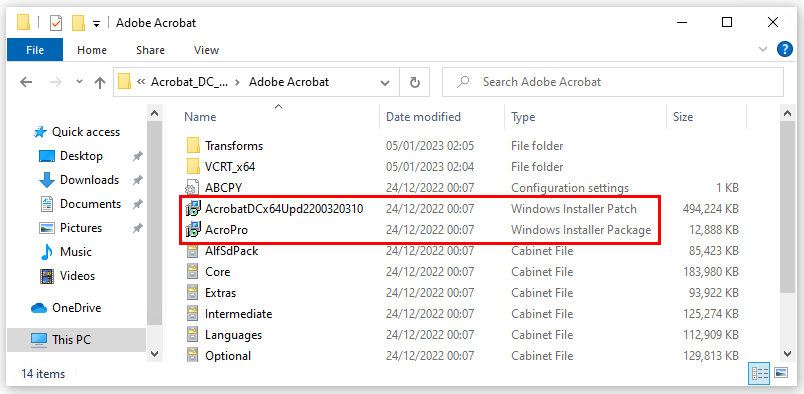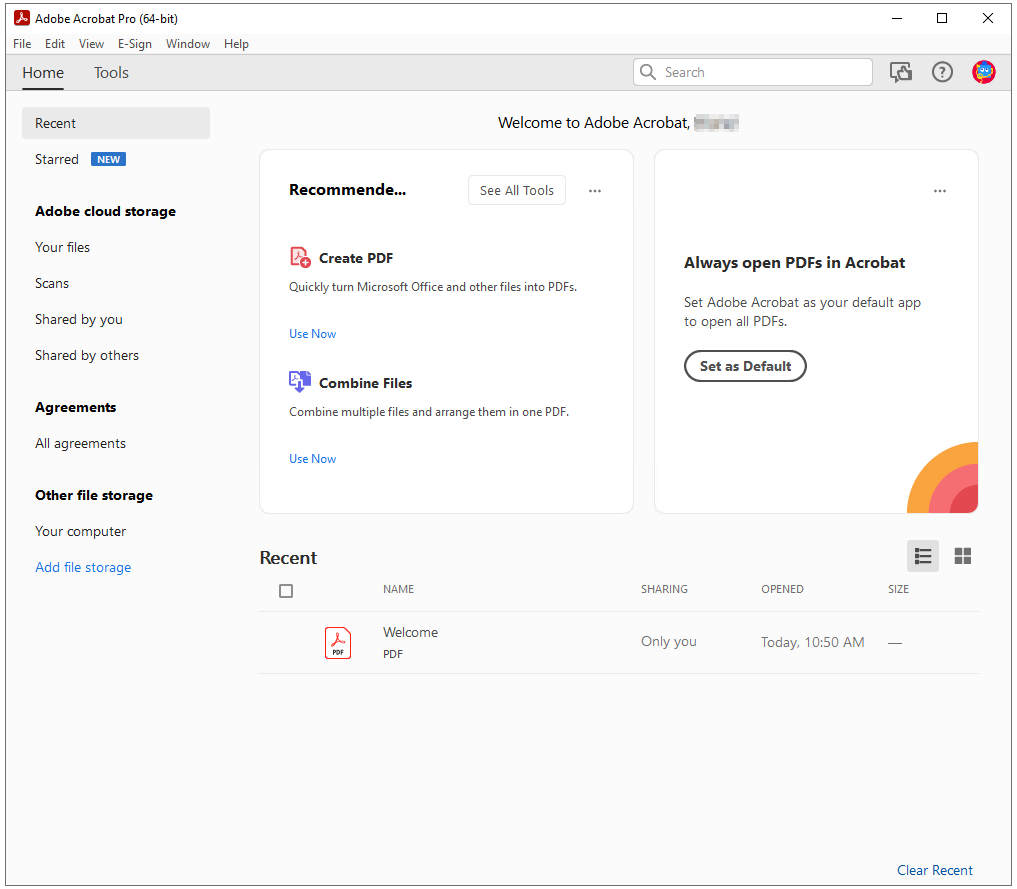Install Adobe Acrobat Pro DC on Virtual Desktop using PowerShell
How to Install Acrobat Pro DC on Virtual Desktop: Download Acrobat Pro DC and extract the MSI file using PowerShell. Configure Acrobat using the Acrobat Customization Wizard. Silent install Acrobat Pro DC from the command line.
Overview
In this example, we are installing Adobe Acrobat on Citrix Virtual Desktop, Windows 10 22H2 multi-session. The steps will be similar for Azure Virtual Desktop (AVD) or Remote Desktop Services (RDS)
In this guide, we will download Acrobat Pro and extract the MSI file using PowerShell. Create a transforms file to customize the Acrobat Pro installation and silent install Acrobat Pro using PowerShell.
Adobe Acrobat 64-bit unified installer
Adobe now provides a 64-bit unified installer that includes both Acrobat Reader and Acrobat Pro
The unified installer will prompt users to sign in and tries to install Acrobat Pro features which doesn't work in a shared non-persistent virtual desktop environment
- When you install Acrobat Pro using the unified installer, it will automatically remove Acrobat Reader
- You can't have both Acrobat Reader and Acrobat Pro installed in a Virtual Desktop environment.
- To workaround this issue, you will need to set MS Edge as the default PDF reader and use Acrobat Pro as the PDF editor
1. Download and install Acrobat Customization Wizard DC
What is the Acrobat Customization Wizard?
You can use the Acrobat Customization Wizard to change installation options and modify registry settings for Adobe Acrobat.
For example, you can configure silent install, suppress reboot and remove the default Acrobat desktop shortcut
The customization wizard generates a transform MST file that is used to apply installation settings when running the Adobe Acrobat MSI installer.
Download Acrobat Customization Wizard
Connect to the Adobe FTP site using FileZilla and download the latest version of Acrobat Customization Wizard DC
ftp.adobe.com
/pub/adobe/acrobat/win/AcrobatDC/misc
CustWiz2000920067_en_US_DC.exe
Install Acrobat Customization Wizard DC
Run the setup file CustWiz2000920067_en_US_DC.exe to install Acrobat Customization Wizard DC
2. Download Acrobat Pro and extract MSI file
The Evergreen PowerShell module can be used to get the download URL for some common Windows applications.
Evergreen PowerShell module
The Evergreen PowerShell module can be used to get the download URL for some common Windows applications.
Install Evergeen PowerShell module
# install prerequisite NuGet Install-PackageProvider -Name NuGet -Force # install Evergreen powershell module Install-Module -Name Evergreen -Force
List Evergreen applications
# Get list of EvergreenApps Find-EvergreenApp > C:\temp\evergreen-app-list.txt
Download Acrobat Pro and extract MSI file using PowerShell
This PowerShell script uses the Evergreen PowerShell module to download the latest version of Acrobat Reader and extract it using 7-Zip
# create install folders
mkdir C:\Install\7-Zip
mkdir C:\Install\AcrobatPro
# get acrobat pro
$AcrobatPro = Get-EvergreenApp -Name AdobeAcrobatProStdDC | Where-Object { $_.Architecture -eq "x64" -and $_.Sku -eq "Pro"}
# download acrobat pro
Invoke-WebRequest $AcrobatPro.uri -OutFile C:\Install\AcrobatPro\Acrobat_DC_Web_x64_WWMUI.zip
# download 7-Zip
Invoke-WebRequest https://www.7-zip.org/a/7z2201-x64.exe -OutFile C:\Install\7-Zip\7z2201-x64.exe
# install 7-Zip
Start-Process C:\Install\7-Zip\7z2201-x64.exe -ArgumentList '/S' -Wait
# extract acrobat pro using 7-Zip
cd "C:\Program Files\7-Zip"
.\7z.exe x "C:\Install\AcrobatPro\Acrobat_DC_Web_x64_WWMUI.zip" -o"C:\Install\AcrobatPro\Acrobat_DC_Web_x64_WWMUI"
The extracted .exe contains the Acrobat Pro installer .msi file and the latest .msp patch file
3. Customize the Acrobat Pro installation
Customize the Acrobat Pro installation using the Acrobat Customization Wizard
Open Acrobat Customization Wizard DC
File - Open package
Browse for the Acrobat Pro .msi fileC:\Install\AcrobatPro\Acrobat_DC_Web_x64_WWMUI\Adobe Acrobat\AcroPro.msi
Personalization Options
Suppress display of End User Agreement (EULA)
Installation Options
Make reader the default PDF viewer
Run installation silently
Suppress reboot
Shortcuts
Remove desktop shortcut
Online Services and Features
Disable product updates
Disable upsell
Direct Editor
ServiceInstall
Drop the row to prevent the installation of the Adobe ARM service
INFO
Adobe Arm is an auto-update utility that downloads and installs new updates for Adobe Reader. Because we are installing Acrobat on non-persistent Virtual Desktops, automatic updates will be disabled.
Generate Transform MST file
Transform - Generate Transform
The transform MST file will be used to apply these settings when running the Acrobat MSI installer
Save the transform fileC:\Install\AcrobatPro\AcroPro.mst
4. Install Acrobat Pro DC using PowerShell
Adobe Acrobat silent install command line switches
Adobe Acrobat MSI installation options
/qn quiet mode, no user interaction
/qb quiet basic, show basic UI
/norestart Do not restart
/qb will show a basic user interface for the installer and will also show you installation error messages.
Silent install Acrobat Pro DC using PowerShell
This PowerShell script installs prerequisites, then installs Acrobat Pro DC using the .msi file and transform .mst file and finally applies the latest Acrobat update using the .msp file.
# install prerequisites # download Visual C++ 2013 Invoke-WebRequest https://aka.ms/highdpimfc2013x86enu -OutFile C:\Install\AcrobatPro\vcredist_x86.exe Invoke-WebRequest https://aka.ms/highdpimfc2013x64enu -OutFile C:\Install\AcrobatPro\vcredist_x64.exe # install Visual C++ 2013 Start-Process C:\Install\AcrobatPro\vcredist_x86.exe -ArgumentList '/install /quiet /norestart' -Wait Start-Process C:\Install\AcrobatPro\vcredist_x64.exe -ArgumentList '/install /quiet /norestart' -Wait # install adobe pro Start-Process msiexec.exe -ArgumentList '/I "C:\Install\AcrobatPro\Acrobat_DC_Web_x64_WWMUI\Adobe Acrobat\AcroPro.msi" /qn /norestart TRANSFORMS="C:\Install\AcrobatPro\AcroPro.mst"' -Wait # install adobe acrobat update Start-Process msiexec.exe -ArgumentList '/p "C:\Install\AcrobatPro\Acrobat_DC_Web_x64_WWMUI\Adobe Acrobat\AcrobatDCx64Upd2200320310.msp" /qn /norestart' -Wait
Users will have to sign in to use Acrobat Pro features
5. Change default PDF reader to MS Edge
Because we can't have both Acrobat Reader and Acrobat Pro installed on the Virtual Desktop, we need to set Microsoft Edge as the default PDF viewer using an app association xml file.
Export app associations XML file
Open PowerShell (run as admin) and run the following command to export file associationsDism /Online /Export-DefaultAppAssociations:C:\Temp\AppAssociations.xml
Edit the file to change the app associations
Change the file association for pdf from Adobe to MS Edge
<Association Identifier=".pdf" ProgId="AcroExch.Document.DC" ApplicationName="Adobe Acrobat Reader DC" /> <Association Identifier=".pdf" ProgId="MSEdgeHTM" ApplicationName="Microsoft Edge" />
Example: AppAssociations.xml
<?xml version="1.0" encoding="UTF-8"?> <DefaultAssociations> <Association Identifier=".htm" ProgId="ChromeHTML" ApplicationName="Google Chrome" /> <Association Identifier=".html" ProgId="ChromeHTML" ApplicationName="Google Chrome" /> <Association Identifier=".MP2" ProgId="WMP11.AssocFile.MP3" ApplicationName="Windows Media Player" /> <Association Identifier=".pdf" ProgId="MSEdgeHTM" ApplicationName="Microsoft Edge" /> <Association Identifier=".svg" ProgId="MSEdgeHTM" ApplicationName="Microsoft Edge" /> <Association Identifier=".tif" ProgId="PhotoViewer.FileAssoc.Tiff" ApplicationName="Windows Photo Viewer" /> <Association Identifier=".tiff" ProgId="PhotoViewer.FileAssoc.Tiff" ApplicationName="Windows Photo Viewer" /> <Association Identifier=".txt" ProgId="txtfile" ApplicationName="Notepad" /> <Association Identifier=".url" ProgId="IE.AssocFile.URL" ApplicationName="Google Chrome" /> <Association Identifier=".website" ProgId="IE.AssocFile.WEBSITE" ApplicationName="Google Chrome" /> <Association Identifier="http" ProgId="ChromeHTML" ApplicationName="Google Chrome" /> <Association Identifier="https" ProgId="ChromeHTML" ApplicationName="Google Chrome" /> <Association Identifier="microsoft-edge" ProgId="MSEdgeHTM" ApplicationName="Microsoft Edge" /> <Association Identifier="microsoft-edge-holographic" ProgId="MSEdgeHTM" ApplicationName="Microsoft Edge" /> <Association Identifier="ms-xbl-3d8b930f" ProgId="MSEdgeHTM" ApplicationName="Microsoft Edge" /> <Association Identifier="read" ProgId="MSEdgeHTM" ApplicationName="Microsoft Edge" /> </DefaultAssociations>
Deploy app associations file using GPO
Use the following group policy settings to set the application file associations on your Virtual Desktops
Computer Configuration - Policies - Administrative Templates
Windows Components - File Explorer
Do not show the 'new application installed' notification:Enabled
Set a default associations configuration file: Enabled
Default Associations Configuration File \\file-share\Citrix\AppAssociations.xml
References:
by Author
Adobe 64-bit Unified App Installer
https://www.adobe.com/devnet-docs/acrobatetk/tools/VirtualizationGuide/singleinstaller.html
Export or Import Default Application Associations
https://learn.microsoft.com/en-us/windows-hardware/manufacture/desktop/export-or-import-default-application-associations
















Comments 2
Thank you for the article. According to the documentation on the Unified Installer page:
"Available features are determined by the licensing/activation credential rather than installing two different products. Users with Acrobat rights get those features on sign-in. Other users get Reader."
Other places in Adobe documentation talk about the unified installer allowing Acrobat to run in Pro, Standard, or Reader, depending on user license. Your article above seems to indicate that it would not function as Reader. Can you speak to what you observed when testing and writing this article? We are actually trying to install with most users with Standard and a couple users with Pro, on a non-persistent VDI, and wondering if we will be forced to setup a 2nd base image.
Hi, Sorry for the late reply! When I tested this, I could not get Adobe to stop prompting people to sign in. Basically, I could not get Adobe to work as “reader” for people without an Adobe Pro license. Have had no issues on Citrix Virtual Desktop using MS Edge as the PDF reader and people with Acrobat licenses can open PDFs in Acrobat Pro to edit them. Hope that helps, good luck!